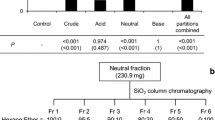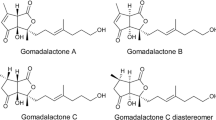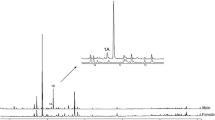Abstract
The cowpea weevil, Callosobruchus maculatus, is a major pest of stored pulses. Females of this species produce a contact sex pheromone that elicits copulation behavior in males. Pheromone was extracted from filter-paper shelters taken from cages that housed females. Crude ether extract stimulated copulation in male C. maculatus. Initial fractionation showed behavioral activity in acidic and neutral fractions. Furthermore, bioassay-guided fractionation and gas chromatography-mass spectroscopy (GC-MS) analysis of active fractions revealed that the active components of the acidic fraction were 2,6-dimethyloctane-1,8-dioic acid and nonanedioic acid. These components along with the hydrocarbon fraction, a mixture of C27–C35 straight chain and methyl branched hydrocarbons, had a synergistic effect on the behavior of males. Glass dummies treated with an authentic pheromone blend induced copulation behavior in males. The potential roles of the contact sex pheromone of C. maculatus are discussed.





Similar content being viewed by others
References
Baker, J. E. and Nelson, D. R. 1981. Cuticular hydrocarbons of adults of the cowpea weevil, Callosobruchus maculatus. J. Chem. Ecol. 7:175–182.
Birch, M. C. 1974. Aphrodisiac pheromones in insects, pp. 115–134, in M. C. Birch (ed.). Pheromones. North-Holland, Amsterdam.
Honda, H. and Ohsawa, K. 1990. Chemical ecology for stored product insect. J. Pesticide Sci. 15:263–270.
Howard, R. W. 1993. Cuticular hydrocarbons and chemical communication, pp. 179–226, in D. W. Stanley-Samuelson and D. R. Nelson (eds.). Insect Lipids: Chemistry, Biochemistry and Biology. University of Nebraska Press, Lincoln.
Howard, R. W. 2001. Cuticular hydrocarbons of adult Pteromalus cerealellae (Hymenoptera: Pteromalidae) and two larval hosts, Angoumois grain moth (Lepidoptera: Gelechiidae) and cowpea weevil (Coleoptera: Bruchidae). Ann. Entomol. Soc. Am. 94:152–158.
Lextrait, P., Biemont, J-C., and Pouzat, J. 1994. Comparison of walking locomotory reactions of two forms of Callosobruchus maculatus males subjected to female sex pheromone stimulation (Coleoptera: Bruchidae). J. Chem. Ecol. 20:2917–2930.
Lextrait, P., Biemont, J.-C., and Pouzat, J. 1995. Pheromone release by the two forms of Callosobruchus maculatus females: effects of age, temperature and host plant. Physiol. Entomol. 20:309–317.
Mbata, G. N., Shu, S., and Ramaswamy, S. B. 2000. Sex pheromones of Callosobruchus subinnotatus and C. maculatus (Coleoptera: Bruchidae): congeneric responses and role of air movement. Bull. Entomol. Res. 90:147–154.
Mori, K. 1997. Pheromones: Synthesis and bioactivity. Chem. Commun. 13:1153–1158.
Mori, K. 2000. Organic synthesis and chemical ecology. Acc. Chem. Res. 33:102–110.
Mori, K., Ito, T., Tanaka, K., Honda, H., and Yamamoto, I. 1983. Synthesis and biological activity of optically active forms of (E)-3,7-dimethyl-2-octene-1,8-dioic acid (Callosobruchusic acid). Tetrahedron 39:2303–2306.
Nakai, T., Yajima, A., Akasaka, K., Kaihoku, T., Ohtaki, M., Nukada, T., Ohrui, H., and Yabuta, G. 2005. Synthesis of the four stereoisomers of 2,6-dimethyloctane-1,8-dioic acid, a component of the copulation release pheromone of the cowpea weevil, Callosobruchus maculatus. Biosci. Biotechnol. Biochem. 69:2401–2408.
Nojima, S., Schal, C., Webster, F. X., Santangelo, R., and Roelofs, W. 2005. Identification of the sex pheromone of the German cockroach, Blattella germanica. Science 307:1104–1106.
Phillips, T. W., Phillips, J. K., Webster, F. X., Tang, R., and Burkholder, W. E. 1996. Identification of sex pheromones from cowpea weevil, Callosobruchus maculatus, and related studies with C. analis (Coleoptera: Bruchidae). J. Chem. Ecol. 22:2233–2249.
Qi, Y. and Burkholder, W. E. 1982. Sex pheromone biology and behavior of the cowpea weevil Callosobruchus maculatus (Coleoptera: Bruchidae). J. Chem. Ecol. 8:527–534.
Ramaswamy S. B., Shu, S., Monroe, W. A., and Mbata, G. N. 1995. Ultrastructure and potential role of integumentary glandular cells in adult male and female Callosobruchus subinnotatus (PIC) and C. maculatus (Fabricius) (Coleoptera: Bruchidae). Int. J. Insect Morphol. Embryol. 24:51–61.
Rees, D. P. 2004. Bruchid or seed beetles, pp. 39–46, in D. P. Rees (ed.). Insects of Stored Products. CSIRO Publishing, Australia.
Rice, W. R. 1989. Analyzing tables of statistical tests. Evolution 43:223–225.
Rup, P. J. and Sharma, S. P. 1978. Behavioural response of males and females of Callosobruchus maculatus (F.) to the sex pheromones. Indian J. Ecol. 5:72–76.
Sakuma, M. 1998. Probit analysis of preference data. Appl. Entomol. Zool. 33:339–347.
Shu, S., Koepnick, W. L., Mbata, G. N., Cork, A., and Ramaswamy, S. B. 1996. Sex pheromone production in Callosobruchus maculatus (Coleoptera: Bruchidae): electroantennographic and behavioral responses. J. Stored Prod. Res. 32:21–30.
Tanaka, K., Ohsawa, K., Honda, H., and Yamamoto, I. 1981. Copulation release pheromone, erectin, from the azuki bean weevil (Callosobruchus chinensis L.). J. Pesticide Sci. 6:75–82.
Tanaka, K., Ohsawa, K., Honda, H., and Yamamoto, I. 1982. Synthesis of erectin, a copulation release pheromone of the azuki bean weevil, Callosobruchus chinensis L. J. Pesticide Sci. 7:535–537.
Tanaka, Y., Honda, H., Ohsawa, K., and Yamamoto, I. 1986. A sex attractant of the yellow mealworm, Tenebrio molitor L., and its role in the mating behavior. J. Pesticide Sci. 11:49–55.
Yajima, A., Akasaka, K., Nakai, T., Maehara, H., Nukada, T., Ohrui, H., and Yabuta, G. 2006. Direct determination of the stereoisomer constitution by 2D-HPLC and stereochemistry–pheromone activity relationship of the copulation release pheromone of the cowpea weevil, Callosobruchus maculatus. Tetrahedron 62:4590–4596.
Acknowledgements
The authors wish to express their gratitude to Drs. Kenji Masuyama and Kaoru Tanaka for their valuable comments and help. We also express our gratitude to Dr. Coby Schal and Elsa Youngsteadt for reviewing the manuscript.
Author information
Authors and Affiliations
Corresponding author
Rights and permissions
About this article
Cite this article
Nojima, S., Shimomura, K., Honda, H. et al. Contact Sex Pheromone Components of the Cowpea Weevil, Callosobruchus maculatus . J Chem Ecol 33, 923–933 (2007). https://doi.org/10.1007/s10886-007-9266-5
Received:
Accepted:
Published:
Issue Date:
DOI: https://doi.org/10.1007/s10886-007-9266-5




